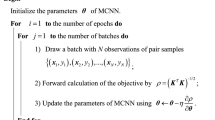Abstract
Quality-related modeling and monitoring which aim at the key performance indicators have received wide attention in the research community. The widely used kernel-based methods mainly map process variables into kernel space without considering the relationship between the high-dimension features and quality indicators; therefore, the modeling performance of such transform cannot be guaranteed. For quality-related kernel learning, we propose a framework consisting of flexible neural transform and fixed kernel mapping. In this framework, neural network is used to learn representations for predicting quality indicators in the following kernel regression models. For monitoring the quality-related and quality-independent information, we present a solution for relevant subspaces decomposition and the diagnostic logic is summarized based on the quality-related and quality-independent statistics. The effectiveness of the proposed method is evaluated by simulations and real industrial-scale process.





Similar content being viewed by others
Data availability
The datasets used during the current study are available at http://web.mit.edu/braatzgroup/links.html.
References
Botev Z, Grotowski J, Kroese D (2010) Kernel density estimation via diffusion. Annals of Stat 38(5):2916–2957
Ding SX (2014) Data-driven design of monitoring and diagnosis systems for dynamic processes: a review of subspace technique based schemes and some recent results. J Process Contr 24(2):431–449
Downs JJ, Vogel EF (1993) A plant-wide industrial process control problem. Comput Chem Eng 17(3):245–255
Ge Z, Song Z, Gao F (2013) Review of recent research on data-based process monitoring. Ind Eng Chem Res 52(10):3543–3562
Ghahfarokhi PS, Podgornovs A, Cardoso AJM, Kallaste A, Belahcen A, Vaimann T (2021) AC losses analysis approaches for electric vehicle motors with hairpin winding configuration. In: IECON 2021–47th annual conference of the ieee industrial electronics society, pp 1–4
Hussain R, Karbhari Y, Ijaz MF, Woźniak M, Singh PK, Sarkar R (2021) Revise-Net: exploiting reverse attention mechanism for salient object detection. Remote Sens 13(23):4941
Jiang Y, Yin S (2019) Recent advances in key-performance-indicator MATLAB toolbox. IEEE Trans Ind Inf 15(5):2849–2858
Jiang Q, Yan S, Cheng H, Yan X (2020) Local-global modeling and distributed computing framework for nonlinear plant-wide process monitoring with industrial big data. IEEE Trans Neural Netw Learn Syst 32(8):3355–3365
Jiao J, Yu H, Wang G (2016) A quality-related fault detection approach based on dynamic least squares for process monitoring. IEEE Trans Ind Electron 63(4):2625–2632
Jiao J, Zhao N, Wang G, Yin S (2017) A nonlinear quality-related fault detection approach based on modified kernel partial least squares. ISA Trans 66:275–283
Li G, Qin SJ, Zhou D (2010) Geometric properties of partial least squares for process monitoring. Automatica 46(1):204–210
Li X, Du Z, Huang Y, Tan Z (2021) A deep translation (GAN) based change detection network for optical and SAR remote sensing images. ISPRS J Photogramm Remote Sens 179:14–34
Peng K, Zhang K, Li G (2013) Quality-related process monitoring based on total kernel PLS model and its industrial application. Math Probl Eng 2013:707953
Qin SJ, Zheng Y (2013) Quality-relevant and process-relevant fault monitoring with concurrent projection to latent structures. AIChE J 59(2):2496–2504
Ruiz-Cárcel C, Cao Y, Mba D, Lao L, Samuel RT (2015) Statistical process monitoring of a multiphase flow facility. Contr. Eng. Pract. 42:74–88
Sahoo KK, Dutta I, Ijaz MF, Woźniak M, Singh PK (2021) TLEFuzzyNet: fuzzy rank-based ensemble of transfer learning models for emotion recognition from human speeches. IEEE Access 9:166518–166530
Wang G, Jiao J (2017) A kernel least squares based approach for nonlinear quality-related fault detection. IEEE Trans Ind Electron 64(4):3195–3204
Wang G, Luo H, Peng K (2016) Quality-related fault detection using linear and nonlinear principal component regression. J Franklin Inst 353(10):2159–2177
Wang Y, Si Y, Huang B, Lou Z (2018) Survey on the theoretical research and engineering applications of multivariate statistics process monitoring algorithms: 2008–2017. Can J Chem Eng 96(10):2073–2085
Weinberger K, Saul L (2006) Unsupervised learning of image manifolds by semidefinite programming. Int J Comp vis 70(1):77–90
Xiong H, Swamy M, Ahmad M (2005) Optimizing the kernel in the empirical feature space. IEEE Trans Neural Netw 16(2):460–474
Yao L, Ge Z (2018) Deep learning of semisupervised process data with hierarchical extreme learning machine and soft sensor application. IEEE Trans Ind Electron 65(2):1490–1498
Yin J, Yan X (2021) Stacked sparse autoencoders monitoring model based on fault-related variable selection. Soft Comput 25(5):3531–3543
Yin S, Li X, Gao H, Kaynak O (2015) Data-based techniques focused on modern industry: an overview. IEEE Trans Ind Electron 62(1):657–667
Yu W, Zhao C (2019) Broad convolutional neural network based industrial process fault diagnosis with incremental learning capability. IEEE Trans Ind Electron 67(6):5081–5091
Yuan X, Huang B, Wang Y, Yang C, Gui W (2018) Deep learning-based feature representation and its application for soft sensor modeling with variable-wise weighted SAE. IEEE Trans Ind Inf 14(7):3235–3243
Zhang K, Hao H, Chen Z, Ding SX, Peng K (2015) A comparison and evaluation of key performance indicator-based multivariate statistics process monitoring approaches. J Process Contr 33:112–126
Zhou D, Li G, Qin SJ (2010) Total projection to latent structures for process monitoring. AIChE J 56(1):168–178
Funding
The authors are grateful for the support of National key research and development program of China (2021YFC2101100), and National Natural Science Foundation of China (21878081).
Author information
Authors and Affiliations
Contributions
All authors contributed to the study conception and design. Data collection, analysis and experiments were performed by SY. The first draft of the manuscript was written by SY, and all authors commented on previous versions of the manuscript.
Corresponding author
Ethics declarations
Conflict of interest
The authors have no relevant financial or non-financial interests to disclose.
Additional information
Communicated by Priti Bansal.
Publisher's Note
Springer Nature remains neutral with regard to jurisdictional claims in published maps and institutional affiliations.
Rights and permissions
About this article
Cite this article
Yan, S., Lv, L. & Yan, X. Neural representations for quality-related kernel learning and fault detection. Soft Comput 27, 13543–13551 (2023). https://doi.org/10.1007/s00500-022-07022-x
Accepted:
Published:
Issue Date:
DOI: https://doi.org/10.1007/s00500-022-07022-x




